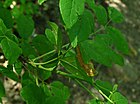Note: This is a project under development. The articles on this wiki are just being initiated and broadly incomplete. You can Help creating new pages.
Zanthoxylum americanum
Zanthoxylum americanum is a prickly, deciduous shrub or small tree that produces suckers and can form dense thickets; it can grow from 1 - 8 metres tall. The plant is harvested from the wild for use mainly as a medicine, but is also the source of an essential oil and the seeds are used as a condiment. The plant is occasionally grown as an ornamental where its prickly nature and suckering habit can produce an effective barrier.
Contents
- 1 Uses
- 2 Parts Used
- 3 Chemical Composition
- 4 Common names
- 5 Properties
- 6 Habit
- 7 Identification
- 8 List of Ayurvedic medicine in which the herb is used
- 9 Where to get the saplings
- 10 Mode of Propagation
- 11 How to plant/cultivate
- 12 Commonly seen growing in areas
- 13 Photo Gallery
- 14 References
- 15 External Links
Uses
Indigestion, Leg ulcer, Fevers, Poor circulation, Back pain, Cramps, Pulmonary problems, Cold, Cough, Toothaches, Swollen joints.[1]
Parts Used
Chemical Composition
It contains Norchelerythrine, 6-acetonyldihydrochelerythrine, p-hydroxybenzaldehyde, vanillic acid, evofilin C, syringaresinol etc.[2]
Common names
| Language | Common name |
|---|---|
| Kannada | |
| Hindi | |
| Malayalam | |
| Tamil | |
| Telugu | |
| Marathi | |
| Gujarathi | |
| Punjabi | |
| Kashmiri | |
| Sanskrit | |
| English |
Properties
Reference: Dravya - Substance, Rasa - Taste, Guna - Qualities, Veerya - Potency, Vipaka - Post-digesion effect, Karma - Pharmacological activity, Prabhava - Therepeutics.
Dravya
Rasa
Guna
Veerya
Vipaka
Karma
Prabhava
Habit
Identification
Leaf
| Kind | Shape | Feature |
|---|---|---|
Flower
| Type | Size | Color and composition | Stamen | More information |
|---|---|---|---|---|
| {{{5}}} |
Fruit
| Type | Size | Mass | Appearance | Seeds | More information |
|---|---|---|---|---|---|
Other features
List of Ayurvedic medicine in which the herb is used
Where to get the saplings
Mode of Propagation
Seeds, Cuttings of half-ripe wood, Root cuttings.
How to plant/cultivate
Prefers a good deep well-drained moisture retentive soil in full sun or semi-shade.[4]
Commonly seen growing in areas
Along riverbanks, In moist ravines, Thickets, Rocky hillsides.
Photo Gallery
References
- ↑ Indian Medicinal Plants by C.P.Khare
- ↑ Chemical constituents
- ↑ [Morphology]
- ↑ Cultivation
External Links
- Ayurvedic Herbs known to be helpful to treat Indigestion
- Ayurvedic Herbs known to be helpful to treat Leg ulcer
- Ayurvedic Herbs known to be helpful to treat Fevers
- Ayurvedic Herbs known to be helpful to treat Poor circulation
- Ayurvedic Herbs known to be helpful to treat Back pain
- Ayurvedic Herbs known to be helpful to treat Cramps
- Ayurvedic Herbs known to be helpful to treat Pulmonary problems
- Ayurvedic Herbs known to be helpful to treat Cold
- Ayurvedic Herbs known to be helpful to treat Cough
- Ayurvedic Herbs known to be helpful to treat Toothaches
- Ayurvedic Herbs known to be helpful to treat Swollen joints
- Herbs with Seeds used in medicine
- Habit - Deciduous shrub
- Index of Plants which can be propagated by Seeds
- Index of Plants which can be propagated by Cuttings of half-ripe wood
- Index of Plants which can be propagated by Root cuttings
- Herbs that are commonly seen in the region of Along riverbanks
- Herbs that are commonly seen in the region of In moist ravines
- Herbs that are commonly seen in the region of Thickets
- Herbs that are commonly seen in the region of Rocky hillsides
- Herbs




